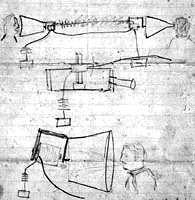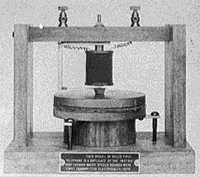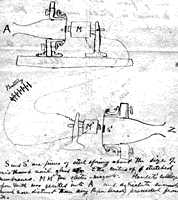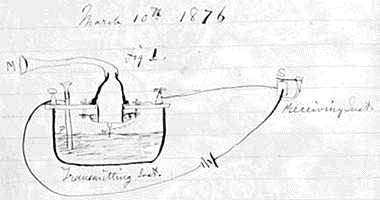
Alexander Graham Bell's design sketch of the telephone. |

[Model of Bell's telephone] |
The telegraph and telephone are both wire-based electrical systems, and Alexander Graham Bell's success with the telephone came as a direct result of his attempts to improve the telegraph.
When Bell began experimenting with electrical signals, the telegraph had been an established means of communication for some 30 years. Although a highly successful system, the telegraph, with its dot-and-dash Morse code, was basically limited to receiving and sending one message at a time. Bell's extensive knowledge of the nature of sound and his understanding of music enabled him to conjecture the possibility of transmitting multiple messages over the same wire at the same time. Although the idea of a multiple telegraph had been in existence for some time, Bell offered his own musical or harmonic approach as a possible practical solution. His "harmonic telegraph" was based on the principle that several notes could be sent simultaneously along the same wire if the notes or signals differed in pitch.
By October 1874, Bell's research had progressed to the extent that he could inform his future father-in-law, Boston attorney Gardiner Greene Hubbard, about the possibility of a multiple telegraph. Hubbard, who resented the absolute control then exerted by the Western Union Telegraph Company, instantly saw the potential for breaking such a monopoly and gave Bell the financial backing he needed. Bell proceeded with his work on the multiple telegraph, but he did not tell Hubbard that he and Thomas Watson, a young electrician whose services he had enlisted, were also exploring an idea that had occurred to him that summer - that of developing a device that would transmit speech electrically. Original drawing of the telephone

Alexander Graham Bell's design sketch of the telephone. |

[Model of Bell's telephone] |
While Bell and Watson worked on the harmonic telegraph at the insistent urging of Hubbard and other backers, Bell nonetheless met in March 1875 with Joseph Henry, the respected director of the Smithsonian Institution, who listened to Bell's ideas for a telephone and offered encouraging words. Spurred on by Henry's positive opinion, Bell and Watson continued their work. By June 1875 the goal of creating a device that would transmit speech electrically was about to be realized. They had proven that different tones would vary the strength of an electric current in a wire. To achieve success they therefore needed only to build a working transmitter with a membrane capable of varying electronic currents and a receiver that would reproduce these variations in audible frequencies.
Bell's great success, achieved on March 10, 1876, marked not only the birth of the telephone but the death of the multiple telegraph as well. The communications potential contained in his demonstration of being able to "talk with electricity" far outweighed anything that simply increasing the capability of a dot-and-dash system could imply.

Letter from Alexander Graham Bell to Alexander Melville Bell and Eliza Symonds Bell, May 5, 1876 |

Bell's Experimental Notebook, 10 March 1876 |